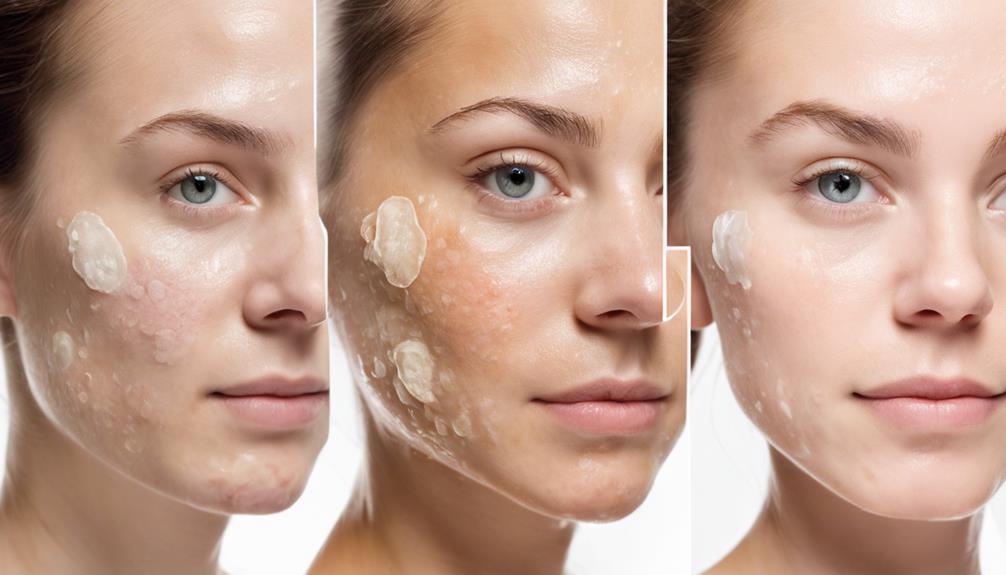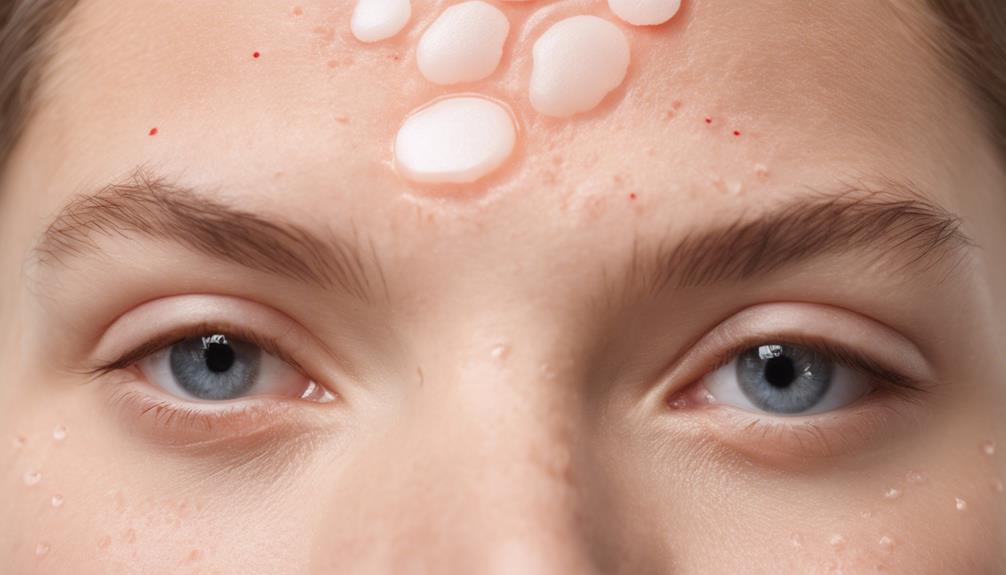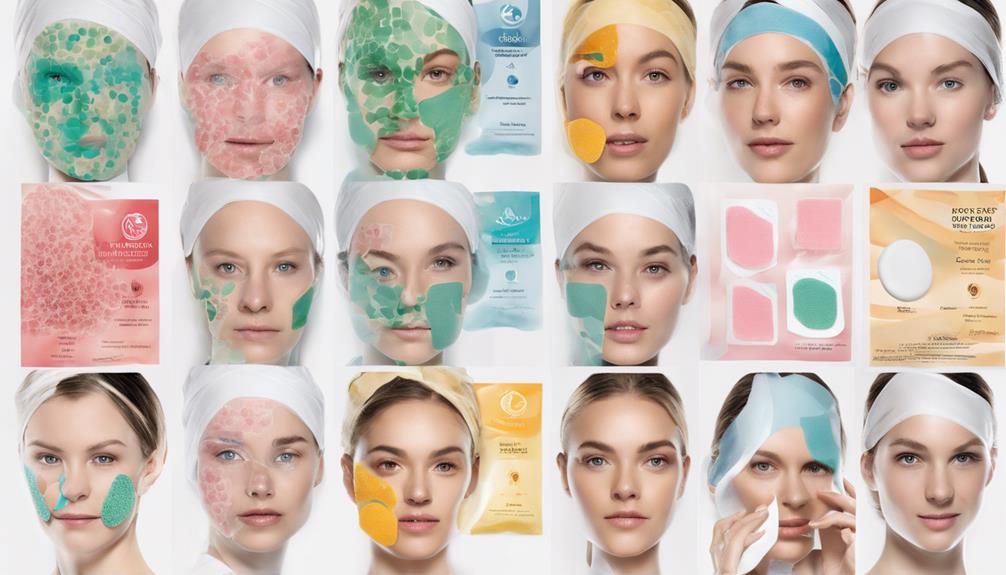Using hydrocolloid patches for cystic acne can significantly enhance the appearance and healing time of stubborn blemishes. These patches actively absorb excess fluid, speed up healing, reduce inflammation, and provide a protective barrier. They operate by absorbing pus, oil, and bacteria, creating an optimal healing environment, and assisting in the recovery process. When applied properly, they combat cystic acne by flattening bumps, expediting healing, and preventing scarring. Before utilizing these patches, evaluate the severity of your acne and take into account your skincare regimen. Hydrocolloid patches offer a focused remedy for cystic acne, effectively addressing concerns about redness, swelling, and pain.
Key Takeaways
- Hydrocolloid patches reduce cystic acne inflammation and redness significantly.
- Before using, assess severity and consider skincare routine adjustments.
- Patches absorb excess fluid, promoting faster healing and preventing scarring.
- Visible reduction in size within hours, leading to smoother skin.
- Pairing with topical medications like salicylic acid enhances effectiveness in treating cystic acne.
Benefits of Hydrocolloid Patches
Hydrocolloid patches actively absorb excess fluid from cystic acne, accelerating the healing process. By drawing out the fluid, these patches help reduce inflammation and redness, providing relief for those struggling with painful cystic acne.
Additionally, they create a protective barrier that shields the acne from external bacteria, preventing further infection and minimizing the risk of scarring. Specifically designed to target deep-seated cystic acne lesions, hydrocolloid patches offer a targeted approach to healing these stubborn blemishes.
Consistent use of these patches can not only improve the appearance of cystic acne but also aid in the overall healing process. With their ability to promote faster recovery and reduce discomfort, hydrocolloid patches are a valuable tool in managing cystic acne effectively.
Embracing the benefits of these patches can make a significant difference in the journey towards clearer, healthier skin.
How Hydrocolloid Patches Work

Absorbing pus, oil, and bacteria from open pimples, these hydrocolloid patches create an ideal healing environment for the skin. By effectively absorbing fluid and impurities, they aid in the process of healing, preventing further infection and promoting faster recovery. These patches are particularly useful for various types of acne, including pustules, papules, and cystic acne that are draining or open.
The hydrocolloid material in these patches acts as a protective barrier that not only absorbs excess fluid but also reduces inflammation, helping to prevent scabbing and promoting smoother healing. This makes them a great option for individuals who may have picked at their skin, as they can prevent further trauma and encourage quicker skin recovery. Overall, the way hydrocolloid patches work is by creating an excellent environment for the skin to heal, making them a valuable tool in managing acne breakouts.
Application Tips for Hydrocolloid Patches
When using hydrocolloid patches, it's important to start by cleansing and drying the affected area before application. This step helps guarantee that the patch adheres well to the skin, creating an ideal healing environment.
Make sure the pimple is open or draining before applying the patch for it to work effectively. When you apply the patch, make sure it's directly over the pimple, pressing gently to secure it in place.
Leaving the patch on for at least 6-8 hours, preferably overnight, allows it to effectively absorb the impurities and promote healing. Hydrocolloid pimple patches are particularly beneficial for treating open, draining pimples like cystic acne, as they create a protective barrier that speeds up the recovery process.
Before Using Hydrocolloid Patches

Before using hydrocolloid patches, it's important to assess the severity of your cystic acne to determine if this treatment is suitable.
Consider how your current skincare routine might impact the effectiveness of the patches and adjust as needed.
Be prepared for a potential difference in healing time compared to other acne treatments you may have tried.
Acne Severity Assessment
Evaluating the severity of cystic acne involves gauging the extent of redness, swelling, and pain present before applying hydrocolloid patches. Cystic acne is known for its deep, painful bumps under the skin, making it one of the most severe forms of acne. These breakouts can be challenging to manage and may result in scarring and emotional distress.
Before using hydrocolloid patches, cystic acne can be visibly red, swollen, and tender to the touch. Understanding the severity of cystic acne helps in choosing the most effective treatment approach. By evaluating the redness, swelling, and pain levels, individuals can better address the discomfort and inflammation associated with severe acne before implementing targeted solutions like hydrocolloid patches.
Skincare Routine Impact
Struggling with persistent cystic acne challenges, our skincare routine had been focused on managing oily skin and addressing breakouts before introducing hydrocolloid patches. Traditional acne treatments like creams and spot treatments were part of our routine, but cystic acne remained a stubborn issue. Painful, deep-seated cystic acne lesions were difficult to effectively treat, leading to concerns about scarring, redness, and inflammation.
Despite efforts to manage oily skin and reduce breakouts, our existing skincare routine didn't show significant improvement in addressing cystic acne. The introduction of hydrocolloid patches aimed to provide a new approach to tackling these challenges and enhancing the effectiveness of our skincare routine in dealing with cystic acne.
Healing Time Comparison
In our experience with cystic acne, the healing process was prolonged and challenging without the use of hydrocolloid patches. Cystic acne typically takes weeks to heal without treatment, leading to inflammation, pain, and the risk of scarring.
Untreated cystic acne often requires medical intervention for effective healing as it can persist for months or even years. Without the aid of hydrocolloid patches, managing the healing time of cystic acne can be a formidable task, impacting both physical appearance and emotional well-being.
After Applying Hydrocolloid Patches

After applying hydrocolloid patches, we notice immediate blemish absorption, with the patches working to draw out pus and impurities effectively. Reduced redness and inflammation are also evident, calming the skin and promoting a smoother complexion.
Additionally, raised acne tends to flatten out, minimizing the prominence of cystic acne and aiding in the healing process.
Immediate Blemish Absorption
Upon application, hydrocolloid patches immediately absorb excess fluid and pus from cystic acne, creating an ideal healing environment by removing irritants, dirt, and pus. This process not only prevents further infection but also speeds up the healing of cystic acne.
Here are three key benefits of immediate blemish absorption by hydrocolloid patches:
- Promotes Faster Healing: By swiftly absorbing excess fluid and pus, hydrocolloid patches help expedite the healing process of cystic acne lesions.
- Prevents Further Infection: The removal of irritants, dirt, and pus reduces the risk of additional infections and complications in the affected area.
- Creates Optimal Skin Conditions: The patches create an environment conducive to healing by eliminating impurities, allowing the skin to recover effectively.
Reduced Redness and Inflammation
Reducing redness and inflammation, hydrocolloid patches effectively diminish the appearance of cystic acne spots. These patches work by absorbing excess fluid from the blemish, creating a protective barrier that prevents further irritation and promotes faster healing.
By maintaining a moist environment, they aid in reducing swelling and discomfort associated with cystic acne. The hydrocolloid patches also draw out pus and impurities, calming the skin and improving its overall condition.
Users commonly observe a visible decrease in redness and size of the cystic acne spot after applying these patches. This reduction in inflammation not only helps the acne spot appear less prominent but also contributes to a quicker healing process, providing relief to those dealing with cystic acne.
Flattened Raised Acne
To achieve a smoother and less raised appearance of cystic acne, hydrocolloid patches are effective at flattening raised bumps by creating an ideal healing environment. When using these patches, they work by absorbing excess fluid and promoting the healing process, resulting in visibly reduced size and inflammation of the raised bumps.
- Absorbing Excess Fluid: The patches draw out impurities and pus from deep within the cystic acne, aiding in flattening the raised bumps.
- Promoting Healing: Hydrocolloid patches create a favorable environment for the skin to heal, leading to flattened cystic acne.
- Smoother Appearance: Consistent use of these patches can result in a smoother, less raised appearance of the acne lesions.
Results of Using Hydrocolloid Patches

After applying hydrocolloid patches to cystic acne, a noticeable reduction in size can often be observed within a matter of hours. These patches work by creating a barrier that speeds up the healing process and prevents scarring. They are effective in absorbing excess oil, pus, and bacteria from cystic acne, aiding in its resolution. Users frequently report reduced redness, inflammation, and discomfort post-application. Visible improvements in cystic acne are typically visible within 24-48 hours of using hydrocolloid patches.
| Benefits of Using Hydrocolloid Patches |
|---|
| Reduces acne size by up to 50% overnight |
| Promotes faster healing and prevents scarring |
| Absorbs excess oil, pus, and bacteria |
| Decreases redness, inflammation, and discomfort |
These results showcase the efficacy of hydrocolloid patches in addressing cystic acne and highlight the benefits they provide in promoting faster healing while minimizing potential scarring.
Combining Hydrocolloid Patches With Other Treatments

Enhancing the effectiveness of acne treatment can be achieved by combining hydrocolloid patches with other treatments. By integrating these patches with complementary strategies, individuals can optimize their acne management.
Here are three ways to enhance acne treatment by combining hydrocolloid patches with other methods:
- Pairing with Topical Medications: Using hydrocolloid patches alongside topical treatments, such as salicylic acid, can expedite the healing process of cystic acne. This combination targets acne from both the surface and within the skin, promoting faster recovery.
- Incorporating into Skincare Routine: Adding hydrocolloid patches to a consistent skincare regimen can't only treat existing cystic acne but also improve overall skin health. This integration ensures that the skin receives continuous care and protection against further breakouts.
- Combining with Lifestyle Changes: Integrating hydrocolloid patches with lifestyle modifications like a balanced diet and stress management techniques can contribute to better acne management. These patches, when used in conjunction with healthy habits, offer a holistic approach to combating cystic acne and promoting clearer skin.
Hydrocolloid Patches for Cystic Acne Scars

Hydrocolloid patches prove effective in reducing inflammation and accelerating the healing process of cystic acne scars. These patches create a favorable environment for healing by absorbing excess moisture and shielding the skin. By soothing irritated skin and diminishing redness and pigment changes, they can also aid in preventing scars from forming. Additionally, hydrocolloid patches are adept at concealing and treating cystic acne scars, enabling the application of makeup over them.
Users have reported significant improvements, with some experiencing up to a 60% reduction in cystic acne overnight after using hydrocolloid patches. By targeting inflammation and promoting faster healing, these patches are a valuable tool in addressing the aftermath of cystic acne. Incorporating hydrocolloid patches into a skincare routine for cystic acne scars can lead to visible enhancements and smoother skin texture over time.
Choosing the Right Hydrocolloid Patch

When selecting the right hydrocolloid patch for cystic acne, it's important to take into account the patch size options and compare adhesive strengths.
The size of the patch should be large enough to cover the entire cystic acne lesion effectively, while the adhesive strength determines how well it stays in place to provide continuous treatment.
Patch Size Options
For ideal coverage and absorption of pus from cystic acne, selecting the right size hydrocolloid patch is crucial. When considering patch size options, keep the following in mind:
- Match the Patch Size to the Pimple: Choose a patch that adequately covers the cystic acne lesion for best healing and protection.
- Consider the Severity: Larger patches are more suitable for bigger cystic acne lesions, while smaller patches work well for less extensive pimples.
- Maximize Effectiveness: Properly sizing the patch helps guarantee maximum absorption of pus, leading to faster healing and reduced inflammation of cystic acne.
Selecting the appropriate patch size can greatly impact the outcome of your treatment, aiding in a quicker recovery from cystic acne breakouts.
Adhesive Strength Comparison
To effectively choose the right hydrocolloid patch based on adhesive strength, assess your skin type and pimple size for best treatment outcomes. Different hydrocolloid patches offer varying levels of adhesion strength to cater to diverse skin needs.
Stronger adhesive patches are beneficial for larger or active pimples, ensuring better coverage and absorption. However, if you have sensitive skin prone to irritation, opt for patches with gentler adhesion to prevent discomfort.
The pivotal role of the patch plays a critical role in its ability to absorb fluids and facilitate healing without causing harm to the skin. By understanding the adhesion strengths of hydrocolloid patches and matching them to your skin type, you can effectively address acne concerns while keeping your skin's sensitivity in mind.
Duration of Hydrocolloid Patch Use

We find that wearing hydrocolloid patches for 6-8 hours overnight proves most effective in absorbing excess fluid from cystic acne. The duration of use plays an important role in the patch's effectiveness, allowing it to work its magic while you catch up on beauty sleep.
Here are some key points to keep in mind:
- Optimal Absorption: Allowing the hydrocolloid patch to adhere to your skin for 6-8 hours overnight gives it ample time to absorb the pus and fluids from the acne, promoting faster healing.
- Individual Variations: While the recommended duration is 6-8 hours, individual preferences and skin sensitivities may vary. Some may find leaving the patch on for slightly longer or shorter periods more suitable.
- Consistency is Key: Consistent overnight use of hydrocolloid patches over several nights can yield significant improvements in reducing inflammation and promoting the healing process of cystic acne. It's essential to incorporate this into your skincare routine for the best results.
Cautions When Using Hydrocolloid Patches

When using hydrocolloid patches, it's important to be mindful of potential skin irritation from the adhesive. While these patches are effective in treating certain types of acne, they may not be suitable for individuals with sensitive skin. The adhesive used in hydrocolloid patches can sometimes cause irritation, leading to discomfort or redness on the skin. It's vital to perform a patch test before applying them to make sure your skin can tolerate the adhesive.
In addition, hydrocolloid patches are most effective for open, oozing pimples and may not be as useful for blackheads or whiteheads. They're designed to create a healing environment for existing acne but don't prevent new breakouts. Some individuals may experience dryness or further irritation when using these patches, limiting their effectiveness for certain acne types. It's important to monitor your skin's reaction and discontinue use if you notice any adverse effects. Always follow the instructions provided and consult a dermatologist if you have concerns about using hydrocolloid patches for your skin care routine.
Hydrocolloid Patches for Different Skin Types

Hydrocolloid patches cater to a diverse range of skin types by offering gentle and effective treatment for various forms of acne. These patches are especially beneficial for oily and acne-prone skin, as they help absorb excess oil and promote healing.
Here are three ways hydrocolloid patches cater to different skin types:
- Suitable for All Skin Types: Hydrocolloid patches are gentle and non-irritating, making them suitable for sensitive skin. They work effectively on different types of acne, including cystic acne, nodules, pustules, and papules, providing relief for various skin conditions without causing further irritation.
- Targeted Treatment for Oily Skin: For individuals with oily and acne-prone skin, hydrocolloid patches offer targeted treatment by absorbing excess oil and preventing it from clogging pores. This can help reduce acne breakouts and improve overall skin health.
- Versatile Usage: Different brands offer variations in patch sizes and thickness to cater to different skin textures and acne severities. These versatile patches can be applied to various areas of the face or body where acne occurs, providing tailored treatment based on individual needs.
Understanding Hydrocolloid Patch Ingredients

When examining hydrocolloid patch ingredients, it's crucial to take into account the patch material composition. Understanding what components make up the patch can shed light on how they work to address cystic acne effectively. The skin benefits explained by these ingredients include roles of salicylic acid, benzoyl peroxide, niacinamide, hyaluronic acid, and plant extracts. By grasping these benefits, we can better comprehend how these patches aid in reducing inflammation, absorbing excess oil, and promoting skin healing. Helpful application tips for best results can further enhance the effectiveness of these patches.
Patch Material Composition
Understanding the composition of hydrocolloid patches involves delving into the intricate blend of materials that make up these innovative acne treatment products. When exploring the patch material composition, it's crucial to ponder the following:
- Polyurethane Film: This material forms the outer protective layer of hydrocolloid patches, shielding the affected area from external elements.
- Inner Fluid-Absorbing Layer: The inner layer of hydrocolloid patches is designed to absorb excess fluids from pimples, promoting skin healing and preventing infection.
- Unique Absorption Properties: Hydrocolloid patches have a distinct ability to absorb infected pus from pimples, creating an excellent environment for skin recovery.
Understanding these components sheds light on how hydrocolloid patches effectively aid in skin healing and tackle cystic acne.
Skin Benefits Explained
Salicylic acid and benzoyl peroxide are key ingredients found in hydrocolloid patches that target acne effectively. These ingredients work to unclog pores, reduce inflammation, and kill acne-causing bacteria, promoting clearer skin. Additionally, ingredients like niacinamide and hyaluronic acid aid in reducing redness, soothing irritation, and promoting skin healing. The combination of these components creates a favorable environment for skin repair by absorbing excess fluid and providing a protective barrier. Below is a table summarizing the skin benefits of hydrocolloid patches:
| Ingredient | Function | Benefit |
|---|---|---|
| Salicylic Acid | Unclogs pores | Targets acne effectively |
| Benzoyl Peroxide | Kills bacteria | Reduces inflammation |
| Niacinamide | Reduces redness | Aids in faster healing |
| Hyaluronic Acid | Hydrates skin | Promotes skin repair |
Patch Application Tips
To enhance the effectiveness of hydrocolloid patches, we recommend familiarizing oneself with proper patch application techniques and the key ingredients they contain.
When applying hydrocolloid patches for cystic acne, consider the following tips:
- Cleanse the Area: Before application, make sure the skin is clean and dry to maximize patch adhesion.
- Avoid Mixing with Benzoyl Peroxide: Refrain from using benzoyl peroxide products simultaneously with hydrocolloid patches, as this may cause skin irritation.
- Apply Gently: Press the patch onto the affected area lightly to avoid disrupting the healing process and allow the ingredients to work effectively.
Hydrocolloid Patches Vs. Traditional Acne Treatments

When comparing hydrocolloid patches to traditional acne treatments, the effectiveness in reducing inflammation, redness, and size of cystic acne becomes apparent. Hydrocolloid patches offer a targeted solution for cystic acne by creating an ideal healing environment that absorbs excess fluid and protects the pimple from further damage. Unlike traditional treatments, hydrocolloid patches work specifically to heal and treat already open or oozing cystic acne, providing quick relief and promoting faster healing.
Traditional acne treatments may not target pus-filled cystic pimples as effectively as hydrocolloid patches do. The focused approach of hydrocolloid patches sets them apart from traditional treatments by directly addressing the needs of cystic acne. By absorbing fluid and creating a barrier against external elements, hydrocolloid patches can expedite the healing process and reduce the visibility of cystic acne faster than traditional treatments. This targeted action makes hydrocolloid patches a valuable addition to skincare routines for individuals dealing with cystic acne.
Addressing Common Concerns About Hydrocolloid Patches

Examining the effectiveness of hydrocolloid patches for treating specific types of pimples is crucial in understanding their potential benefits. When it comes to addressing common concerns about hydrocolloid patches, it's important to take into account the following:
- Effectiveness on Cystic Acne: Hydrocolloid patches are effective for treating open, draining, and healing pimples like cystic acne. They work by absorbing the fluid from the pimple and creating an ideal healing environment to aid in faster recovery.
- Limitations: Pimple patches aren't suitable for closed or deeper lesions, blackheads, or whiteheads. While they can reduce inflammation and the size of blemishes, they aren't preventive and only treat existing active bumps.
- Comparative Effectiveness: Pimple patches may not be as effective for cystic acne or large breakouts compared to other treatments. It's crucial to take into consideration the severity and type of acne when deciding on the best treatment method for each individual case.
Frequently Asked Questions
Do Hydrocolloid Patches Help Cystic Acne?
Yes, hydrocolloid patches are effective for treating cystic acne. They work by absorbing excess fluid, preventing scarring, and reducing inflammation.
These patches are best used on cystic acne that's already draining. They can notably reduce the size and redness of cystic acne lesions overnight.
Specifically designed to target deep, painful cystic acne, they provide an effective solution for managing this type of acne.
Do Pimple Patches Work on Cysts Before and After?
Pimple patches can indeed work wonders on cystic acne, both before and after application. They help reduce inflammation and promote healing by creating an ideal environment for recovery.
Before use, cystic acne can be painful and swollen, but after applying hydrocolloid patches, the redness and size often diminish. Consistent use can lead to faster healing, minimized scarring, and an overall improved appearance.
These patches are a game-changer in the battle against stubborn cystic acne.
Can a Pimple Patch Help Drain a Cyst?
Yes, a pimple patch can help drain a cyst by absorbing excess fluid and promoting a healing environment.
These patches work best on cysts that have already opened, allowing them to absorb pus and bacteria.
By creating a barrier, they keep the area clean and protected from further infection, reducing inflammation and promoting faster healing.
While not a cure, hydrocolloid patches can aid in managing cystic acne effectively.
How Long Does It Take for Hydrocolloid Patches to Work Acne?
Hydrocolloid patches typically start working on acne within a few hours of application, with significant improvements in cystic acne visible overnight.
For best results, patches may need to be worn for 6-8 hours to effectively reduce inflammation and redness. Consistent use can lead to faster healing of cystic acne lesions by creating an ideal healing environment.
Trust us, these patches work wonders on acne!
Are Hydrocolloid Patches Effective for Treating Pimples as Well?
Yes, you can zap pimples with acne patches! Hydrocolloid patches are incredibly effective for treating pimples by absorbing excess oil and pus, reducing inflammation, and preventing further contamination. They create a barrier that allows the affected area to heal faster and with less scarring.
Conclusion
To sum up, hydrocolloid patches are an effective way to tackle cystic acne.
While some may be hesitant to try them due to concerns about effectiveness, these patches have been shown to greatly reduce inflammation and speed up the healing process.
By incorporating hydrocolloid patches into your skincare routine, you can effectively target stubborn cystic acne and achieve clearer, healthier skin.
Claire has a knack for turning complex dermatological concepts into engaging, easy-to-understand articles. Her work primarily focuses on creating detailed reviews and thought-provoking articles in the “Vetted” category. Claire’s writing not only informs but also inspires our community to try new skincare solutions.









